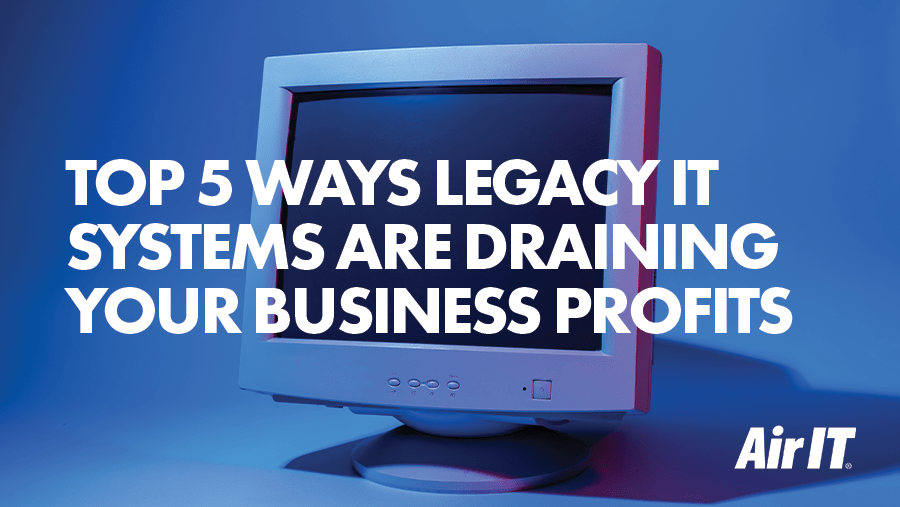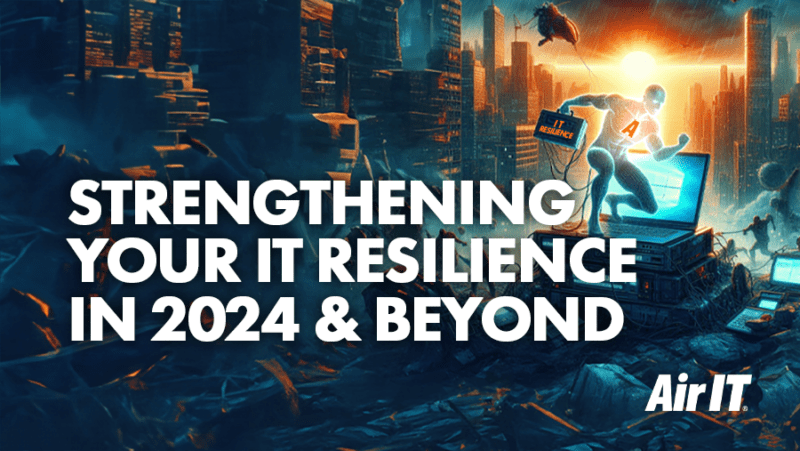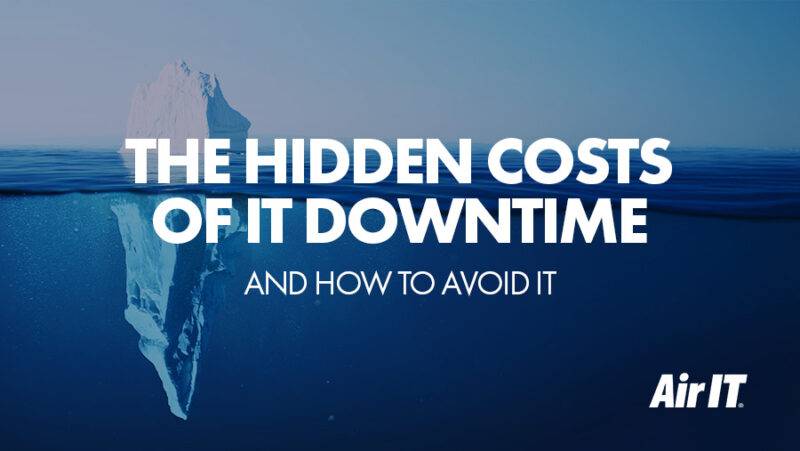Investing in new technology may seem costly, which is why a number of businesses choose to use their legacy technology longer than they should. In this article, we'll be exploring the consequences of relying on outdated technology and how failing to upgrade could mean you are paying the price.

What is legacy IT infrastructure?
Legacy IT infrastructure refers to outdated or ageing hardware, software, and related business processes that are still in use within an organisation. These systems may continue to serve the organisation’s needs to some extent, but they pose challenges due to their outdated technology.
Barriers can prevent businesses from investing
Technology is always evolving with new advancements making it more efficient and powerful. With technology evolving so quickly, many businesses may struggle to keep up and instead remain reliant on their legacy IT systems.
Updating outdated technology can be an investment (in time and money) and many businesses can be put off. Here are some reasons why:
- Higher costs – updating and replacing old technology requires financial investment.
- Perceived loss of productivity – updating hardware/software or replacing devices takes time. The team will also need to be brought up to speed with new technology.
- If it works, don’t change it – if old technology seems to be working correctly, many business owners opt not to replace it until it’s broken in a bid to save money.
- Inconvenience – it can be a real pain changing PCs, especially if the one you have is set up just the way you want it and you don’t want anything to change.
Adopting newer technology is essential for business and commercial success due to the increased efficiency of systems, the productivity of employees and security. Businesses should look beyond immediate effects and invest in the long-term, as many other issues can arise as a consequence of using old technologies…
5 reasons why using legacy IT systems is costing your business:
1. Reduced productivity
Old technology runs slower, takes longer to execute tasks and requires time-consuming maintenance, patches and updates. If your technology is not up-to-date and lacks speed, it will be unable to fulfil the needs of your business and customers. Microsoft estimates that a PC that is more than 4 years old is 2.7 times more likely to be repaired, resulting in 112 hours of productive time lost.
With this in mind, there’s no surprise that outdated technology not only has a significant impact on productivity but also employee morale as employees become frustrated with simple tasks taking longer than necessary.
According to research conducted by Curry’s, UK workers tend to lose around 46 minutes each day due to slow technology, this amounts to a significant 24 days’ worth of work time per year. The research also suggests that 1 in 10 would even consider leaving their job because of this.
Updating your technology is essential to improve productivity and employee retention. Whilst updating technology is a financial investment, it’s also an investment in your employees. A happy workforce, with engaged employees are more invested in their work, and are more likely to drive business success.
2. Security risks
Businesses that use legacy IT systems increase their risk of a cyber attack or breach, due to older systems being an easier gateway for cyber criminals, by not having the latest security features.
Hackers are able to find vulnerabilities in older systems that have not been updated with security patches or software updates. Modern PCs often include advanced security architecture and features that older machines don’t have.
You should also aim to upgrade any end-of-life systems you may be running before they stop receiving updates. For example, Windows Server 2012 is due to stop receiving critical patches and security updates from 10th October, 2023 so if you’re still running this server version then it’s time to think about upgrading now.
Additionally, Windows 10 will reach its end-of-life date on 14th October 2025. It’s important to upgrade all devices that are running Windows 10 to Windows 11 to receive critical updates and security patches.
3. Increased downtime
Older technology is prone to experience errors or may even completely break beyond repair which increases periods of downtime. When a computer breaks, it can take hours or even days to fix the damaged parts. The risk of data loss also increases.
Not only does this result in a loss of productivity but it also means a loss of revenue for the business. According to research conducted by Currys, the amount of time an employee loses to old technology each day can cost a business approximately £2,752 (based on the average UK salary). This is often far more than the cost of replacing old for new, so aging technology should be reviewed regularly.
Downtime caused by technology can strike at the most inconvenient times and can significantly affect critical business processes.
Imagine it’s 4pm on a Friday afternoon and you are about the run payroll for the whole company. Your PC has been displaying signs of issues for several weeks now, but due to time constraints, you’ve reluctantly chosen to overlook the warning signals, hoping they would resolve themselves. Your PC grinds to a halt at the worst possible time and now your team might not get paid on time – your worst nightmare!
4. Higher costs
It’s inevitable that with prolonged use, technology will start to get slower, break down or fail. Broken devices can sometimes be difficult to repair or replace which can often result in high costs. As well as being 2.7 times more likely to break, a PC that is more than 4 years old is said to cost £2,199 according to Microsoft, which is enough to replace it with two or more newer models.
Old systems typically don’t have the latest modern power-saving technology of newer equipment, potentially hindering your efforts if you’re trying to reduce energy costs within your business. By investing in newer devices, you could potentially make major energy savings.
As well as being more energy-efficient, newer computers have a smaller carbon footprint, aligning with many companies’ goals of becoming more sustainable and environmentally responsible.
Although investing in newer technology may initially require a significant investment, the long-term maintenance and running costs of using outdated technology will only become more expensive over time.
5. Compatibility problems
When new software versions are introduced, they often demand more powerful hardware specifications compared to previous versions. If users don’t upgrade their hardware accordingly, they may encounter difficulties running the latest software correctly or even fail to run it all together.
Compatibility problems can restrict your company by prohibiting employees from fully utilising the most up-to-date technology, which can be a disadvantage when compared to businesses that can use the newest advances in technology.
When is the right time to upgrade my business technology?
It is recommended by Microsoft to replace PCs when they are no more than 4 years old, as this is when they start to become more costly to maintain than to replace.
When purchasing technology, it is always recommended to invest in a warranty to ensure you are covered for any potential issues with your device right from the start. However, once your warranty expires, you may want to consider upgrading your device as it can lead to long-term cost savings.
How easy is it to upgrade?
At Air IT, we make it much easier to upgrade outdated technology. Here’s how we can help:
- Finance options – you can lease a PC if you don’t want to buy, it’s a much lower cost than you think, and our fixed priced model benefits your cash-flow and financial planning.
- Data Back-up – We back up your data and rebuild your new laptop to ensure it is set up exactly the way you prefer.
- Network Monitoring – We run tests on your new PC assessing its performance, functionality and hardware, saving you the time and effort.
- IT Support – We are there on site or on the end of the phone if you ever need support.
- IT Disposal – We will ensure that your old device is wiped and recycled in a responsible manner.
- Device Trade-in – your old technology can be used to offset against the cost of a new purchase with our Tech-as-a-Service solutions. With monthly or quarterly subscriptions, you can modernise your IT infrastructure and ensure financial security and company sustainability.
If your business can’t afford to upgrade right now, or you can’t afford the disruption, there are many measures you can put in place to best protect your current devices:
- Performing extra back up cycles – protects against data loss caused by hardware failures and provides an extra layer of data redundancy if one backup fails or becomes corrupted.
- Buy a spare or two to keep on site – having a spare laptop on-site eliminates the need to wait for a new one to be purchased or delivered, also minimising downtime which could cost your business.
- Buy extended warranty – prolongs the standard warranty period provided by the manufacturer, meaning you have an extended timeframe during which you’ll be covered for repairs or a replacement.
How can I dispose of my old business technology?
Air IT work with a trusted Waste Electrical and Electronic Equipment (WEEE) company to dispose of outdated technologies. If your business has ageing IT equipment that is no longer needed, you may wish to consider recycling options.
By recycling your old technology, all business data will be erased of all personal and sensitive data and refurbished for further use.
If any devices cannot be repurposed, it will be stripped of any raw materials and processed for secure disposal.
Recycling old technology is a great way for businesses to reduce their environmental impact and obtain a little cashback!
Lee Johnson, CIO/CISO at Air IT says:
Continuing to use outdated technology can restrict your business, affect growth and can leave you vulnerable to cyber-attack. If businesses want to be one step ahead and reduce their chance of being susceptible to attack, they must ensure they are utilising up-to-date technology and not relying on legacy/outdated software within their organisations.
By investing in new technology, you unlock the power to improve efficiency, boost productivity and improve profitability, allowing your business to achieve success.
Take the Next Step – Modernise your Legacy Infrastructure
IT infrastructure plays a pivotal role in supporting the operational backbone of every organisation. Despite its importance, various barriers can prevent businesses from investing in this crucial aspect.
However, relying on outdated technology can expose your business to substantial risks, potentially leading to expensive consequences.
Discover more ways to minimise risk to your business by Strengthening your IT Resilience!





